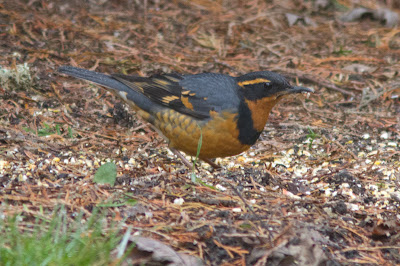This Yellow- x Red-shafted "hybrid" Flicker has A LOT of yellow under its wings and tail.
Northern Flickers come in two varieties (subspecies): The "Red-shafted" Flickers that are abundant here out West and the "Yellow-shafted" subspecies that predominates East of the Rockies. Red-shafted Flickers have salmon coloring underneath their wings and tail feathers, no coloring on the nape (back of the head), and the males have a red malar stripe ("moustache"). Yellow-shafted Flickers have yellow coloring underneath their wings and tail feathers, a red mark on the nape, and the males have a black malar stripe. The two subspecies interbreed in the Mountain West (hybrids are easy to find in Central and Eastern Oregon) and many of these individuals winter West of the Cascades. Hybrid flickers are common out here in the winter, and the vast majority of them look like Red-shafted Flickers with light red marks on their napes (see photo below). Their plumage implies that they have more Red-shafted "blood" than Yellow-shafted (though that's not necessarily true). So I was very surprised to see the individual pictured above, with very bright yellow underparts and a relatively strong red mark on the nape. It basically looks like a male Yellow-shafted Flicker with a red malar stripe.
This is more typical of the "hybrid" flickers that we see in Western Oregon. The red mark on the nape is fainter and the coloring under the wings and tail (not shown) is salmon.
Over the past month and a half, Townsend's Warblers and Ruby-crowned Kinglets have become much more frequent in the yard. This usually happens at this time of the year, as natural food sources begin to run thin. I have no doubt that the overnight lows in the low-to-mid 20's that we experienced in mid-January were a major factor. At least two Townsend's Warblers and one (male) Ruby-crowned Kinglet are regulars at the suet feeders.
A male Townsend's Warbler hunkers down in one of the wax-myrtle shrubs.
Robins, Varied Thrushes, and European Starlings have also been very regular in the yard recently. This is also about normal for this time of the season. Starlings tend to roam urban areas in large flocks in the early winter, and the other two species tend to loosely associate. I tend to not host many robins, so it's been nice to see them over the past few weeks.
This male Varied Thrush has transitioned its died from apples to sunflower chips.
A robin snacks on apples in the freezing fog.
Sparrow numbers have tailed off since November and December, but I'm still hosting two White-throated Sparrows. The tan-striped morph is the most prevalent of the two. Song Sparrows are spotty, I have yet to see my first White-crowned Sparrow, and I haven't hosted a Fox Sparrow since last May. But I am still seeing the occasional Golden-crowned Sparrow. And, of course, juncos are omnipresent.
Our resident tan-striped morph White-throated Sparrow
Golden-crowned Sparrows have become less frequent visitors since December.
One of the stranger things about this winter is the lack of American Goldfinches and House Finches. The latter haven't been around since mid-December and I think I've hosted the former once since mid-November. On the other hand, Lesser Goldfinch and Pine Siskin numbers have been on the rise over the past month. (Most likely owning to the less frequent visits from the local Cooper's Hawks.) An adult male Purple Finch was observed way up in one of the neighbor's Silver Maples a couple of weeks ago, and I observed a female Evening Grosbeak high atop a 100' Douglas Fir a few yards over later that week. But neither visited a feeder. I expect to see more Purple Finches in late March and April, as they begin moving into their breeding areas in the coniferous forests outside of town. Evening Grosbeaks are always a crapshoot. They tend to leave town in May, though I would have a reasonable chance of seeing a small flock next weekend.
A small flock of Lesser Goldfinches energies on a cold January morning.
This female Evening Grosbeak was calling from high atop a Douglas Fir, but never came down to the feeders.
We've been fortunate in a number of ways this winter. Red-breasted Nuthatches are one of my favorites and they were very sporadic last winter. So I'm very happy to report that RB Nuthatches have become bona-fide regulars. Same goes for Chestnut-backed Chickadees.
Interestingly, a couple of regulars from last winter have also become more sporadic this year. Spotted Towhees have been in short supply since the beginning of the year and Bewick's Wren numbers have been overall since the early fall.
This Bewick's Wren was a pleasant mid-January surprise. I took this photo through a dirty window, one-handed, while talking to my mother on the phone. Not bad, considering.
This very young female Anna's Hummingbird has been visiting the nectar feeder since at least November.
As I mentioned in my last post, a very young female Anna's Hummingbird has been visiting my nectar feeder since at least November. This confused me a bit, since Anna's Hummers typically breed in February and March. By this time of the year, young females should have a well-defined red gorget (throat) patch and tail feathers that extend beyond their wing tips. The individual shown above is almost certainly less than 6 months old. I didn't realize that Anna's Hummers were opportunistic enough to breed late in the summer. Thanks to Alan Contreras and Stephanie Hazen for this information.
Well, that's it for now. I hope to see a Fox Sparrow and possibly something rather exotic like a Red Crossbill or Mountain Chickadee later this month. Until then...










